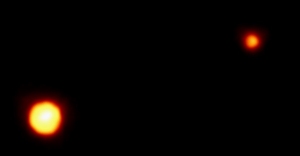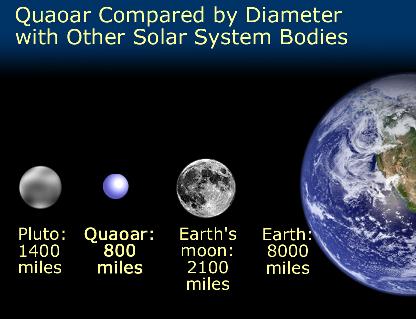






Editor: Kris Cerone
Dethroning Pluto
By Robert Gounley
 |
| Hubble image of Pluto (left) and Charon, 1995. Photo NASA/STScI. |
The Roman gods have suffered a lot in the two thousand years since they were widely worshipped. Once, people spoke their names only in the greatest reverence, fearful that a capricious deity could smite mere mortal with plagues and floods. Today Mars, the Bringer of War, graces candy bar wrappers of. Every morning Mercury, the Messenger of the Gods, has its name taken in vain by angry drivers with cars that won't start.
Pluto, the God of the Underworld, has suffered the most. Besides having his name applied to a rather silly cartoon character, the planet bearing his name may soon be officially demoted. If so, one of the reasons may a discovery by astronomers at Caltech. In further contemporary twist of "political correctness", an object named for the deity of the tribe who first settled Los Angeles may diminish the special status accorded a Roman god.
Our story begins nearly a century ago. Astronomers then believed Neptune, then the farther known object in the solar system, was lagging ever so slightly in its predicted course. They reasoned the gravity of another distant but undiscovered planet, dubbed "Planet X", might be tugging on it. (A century earlier, astronomers saw similar unexplained motions with the planet Uranus and their calculations led them to Neptune.) The search was on.
One searcher was a young American astronomer named Clyde Tombaugh. By night he used a large telescope at the Lowell Observatory to photograph sections of the sky; by day, he meticulously scanned the photographic plates looking for the telltale motion of an undiscovered planet at the farthest reaches of the solar system. In 1930, he noticed a spot on his photographs that moved by just the right amount. Measurements showed the object was orbiting in a long ellipse, pitched steeply from the plane of the rest of the solar system. Newspapers quickly decided this must be "Planet X". It was given the name Pluto - a proper title for a world so cold and distant.
Tombaugh became one of the most famous astronomers of all time. An enthusiastic lecturer even into his 90s, he delivered hundred of astronomy lectures to audiences around the world. Many of his students became planetary scientists and aerospace engineers. Thousands more learned to love the night sky.
For all his work, Tombaugh deserves great praise. However, the source of his fame has not lived up to all the expectations of a planet. For starters, Pluto is far too small to have any significant effect on Neptune's orbit. For decades, every time an astronomer made a more accurate measurement of Pluto's size, the result was nearly always smaller than before. (An article in an astronomical magazine jokingly plotted Pluto's size versus measurement date and predicted when the planet would disappear altogether.) Today, we know that Pluto is about two-thirds the diameter of Earth's moon - dwarfed by its gigantic neighbors Neptune and Uranus.
 |
| Illustration NASA/STScI (A. Feild). |
Though small, Pluto has some other features to recommend it for membership in the planetary fraternity. It has a frozen atmosphere that thaws when, as now, the planet is nearest to the Sun in its orbit. While a few of the larger moons of other planets have denser atmospheres, Pluto is unique in the extreme density variations throughout its year.
More recently, astronomers found that Pluto has a large moon of its own. Named Charon, the satellite seemed to assure Pluto's status as a planet. Up to that time, the only solar system objects known to have other object orbiting them were planets.
That distinction fell away in 1993 when the Galileo spacecraft photographed asteroid Ida and detected a still smaller asteroid orbiting around it. Since then, Earth-based telescopes have detected several other asteroids with smaller moonlets. Within a short time, astronomers who once thought that such asteroids might be possible but rare now declared they must be commonplace.
A more telling discovery was made in 1992 when astronomers at the University of Hawaii discovered another tiny body even farther from the Sun than Pluto. Suddenly, Pluto was no longer the lone gatekeeper at the edge of the solar system. Astronomers, using more powerful telescopes than ever Tombaugh had, began to find many more. Today, about 80 trans-Neptunian objects have been discovered. A few appear to have moons. Some astronomers think 10,000 more of these ice-balls are waiting to be catalogued.
These discoveries were not entirely unexpected. Scientists had long suspected that some comets might come from a region, dubbed the Kuiper Belt, just beyond Neptune's orbit. What was surprising was that the objects found so far were so large - hundreds of kilometers in diameter. Might Pluto and Charon be merely the largest examples of a new class of solar system bodies?
The topic creates arguments wherever planetary astronomers gather. Now, a new Kuiper Belt Object has made the debate even more interesting. Astronomers from Caltech announced the discovery of an object about quarter the diameter of Earth's Moon orbiting almost as far from the Sun as Pluto. They named the new object "Quaoar" (pronounced KWAH-o-ar) after the creation force of the Tongva tribe who were the original inhabitants of the Los Angeles basin.
Pluto remains the largest object known beyond Neptune, but Quaoar's size makes the discovery of still larger Kuiper Belt Objects seem probable. Some scientists have already stopped calling Pluto a planet. In less than a generation, our perception of Pluto has changed from being a lonely sentinel to be one a large, extended family.
Whatever the outcome, this family deserves our attention. Scientists believe they are the building material scraps left over from planetary formation. In a sense, studying Pluto and its neighbors will show us our solar system's blueprints. This past month, Congress approved funding to build a spacecraft to do that exploration.
Perhaps, by the spacecraft arrives at Pluto, it will have been dethroned as a planet. No matter. It will still take us on a trip back to when the solar system was young.
Besides, what's in a name?
For more information on Quaoar, see http://www.gps.caltech.edu/~chad/quaoar/
For more information on Kuiper Belt Objects, see http://www.ifa.hawaii.edu/~jewitt/kb.html.
Copyright © 1998-2003 Organization for the Advancement of Space Industrialization and Settlement. All Rights Reserved.